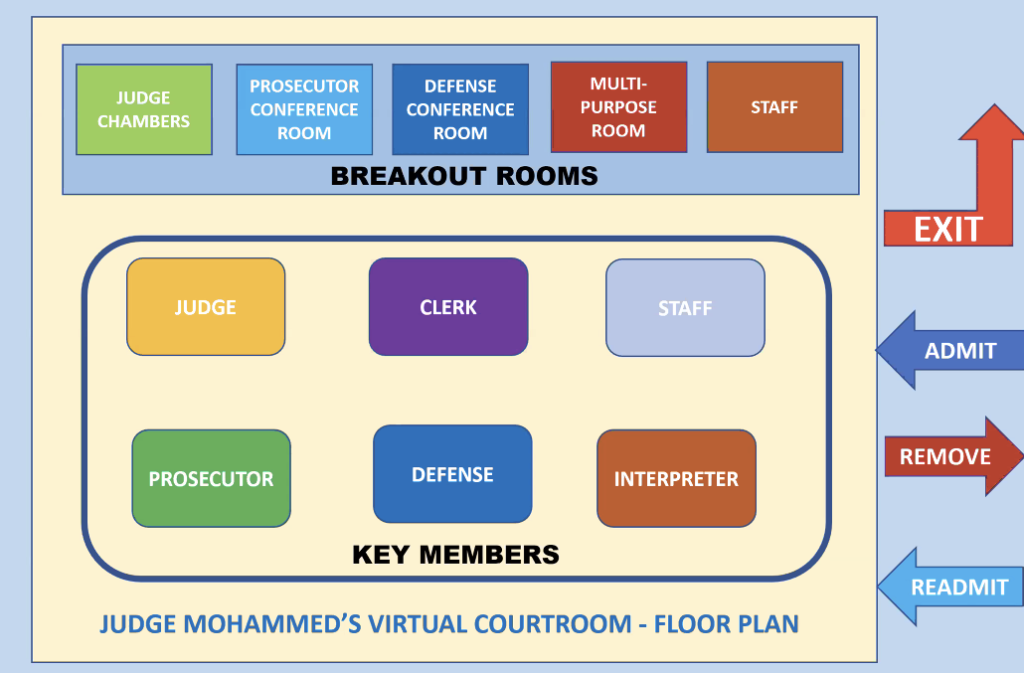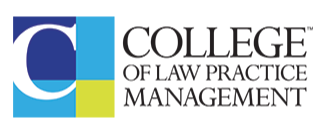Litigation, ADR, ODR—The Next Normal? a live blog post of a College of Law Practice Management virtual event. As with all my live posts, please forgive typos and misunderstandings of meaning. (Note abbreviations: ADR = alternative dispute resolution. ODR = online dispute resolution)
The session description is below; the panelists are:
- Jordan Furlong, moderator—author, speaker, analyst, forecaster at Law 21.
- Nicole Nehama Auerbach—litigator, co-founder of pioneering law firms Valorem Law and ElevateNext.
- Sohail Mohammed—electrical engineer, New Jersey Superior Court Judge, court innovator and teacher.
- Darin Thompson—lawyer, teacher, knowledge engineer for the Civil Resolution Tribunal, British Columbia.
Jordan sets the context of all the changes in dispute resolution and courts wrought by the global pandemic. Today’s session explores two questions
- Are what we are experiencing now – heavily virtual – the new normal?
- Irrespective of that answer, what has worked and what can work better in virtual and online dispute resolution
Judge Mohammed on his take on these questions: The last three months have been the ride of a lifetime. On march 12, the New Jersey Chief Justice announced the courts going all virtual. Likens this to the announcement of going to the moon – but with only 24 hours! In just over one week, 95% of NJ judges and staff were available online. The courts have conducted 35k virtual hearings with 350k participants.
In NJ, the virtual transition started with training judges, then law clerks, then the bar association. Reports that everyone embraced the virtual approach and says that he expects many virtual proceedings to continue.
Judge M conducted a virtual proceeding 5 years ago but he was the only one virtual. Now, all are virtual as illustrated in this schematic:

Judge M cites an example of a car mechanic who appeared in court on Zoom – he did not have to lose a day of work. You see the car on jacks along with him as a participant.
Jordan notes that we no longer have to accept the assumptions that all participants must stop their lives to resolve disputes. While there are losses in going virtual, there are many benefits.
Nicole Auerbach on these questions, as a trial lawyer: Nicole reports she loses a lot of time waiting around in court rooms for her time – and traveling there. Now, she has recovered that time and looks forward to saving that time in the future. The ability to have breakout rooms virtually is huge. It overcomes the problem of private party discussions.
But she says there are downsides, even with improvements in tech and more experience with virtual. Nicole worries about jury trials and observing people’s reaction. It’s hard to use your EQ remotely (emotional quotient). If something is on screen, you may miss the reaction of the judge or jurors – and those reactions are important to adjust the advocacy process.
Nicole (whom I know to be pretty digital) says she uses paper in court. Now she asks if she will move to digital when going virtual. Reports paper provides faster and multiple access points.
Another downside is limited public access. Public scrutiny helps keep the system more unbiased. Research shows that observation by the public changes outcomes.
Virtual may also damage learning. She learned by observing court proceeding early in her career. That may be hard to replicate virtually.
Jordan cites an example of having binders behind disputants in the past. Now it can be digital. Cites example of lawyer who turned around on virtual call for a reference but then stopped when he saw it flash onscreen. Notes there will be adjustments like this as there is more virtual
Darin Thompson on the questions, especially WRT digitization: If we try to create a digital equivalent of an existing process, that’s digitization. In contrast, if we reinvent the process, that’s transformation, which entails new processes that create new value. The line between digitization and transformation may, however, not alway be clear.
Either way, we need to restore access to justice and digitization helps. Asks how we might transform – to “leap frog” to skip an evolutionary step. Cites as example as countries that skipped copper phone lines and went direct to mobiles. Do we have conceptually similar opportunities to resolve disputees?
We need justice – and we can use new processes to satisfy our objectives of a fair and equitable process. You need to look at the “why” – why do we have certain processes. This invokes intentional design for new processes to achieve goals – what does the process look like if you start over and get to the end goals in a totally different way.
Darin had an opportunity to work on disputes in a new way for thee 2% of claims that could be resolved in new ways, citing several types of smaller claims, eg, <$5k small claims. System he created uses an expert system – used over 100k times – to give disputants advice before they even file. Other elements of the system include online facilitation and digital case management. If the dispute cannot be resolved through digital mediation, it moves to traditional dispute resolution. See Civil Resolution Tribunal (based on British Columbia).
Darin reports very high satisfaction with CRT during pandemic based on user surveys.
Tips: (1) if changing your approach, don’t start by focusing on the tech. Focus on creating on “insanely great processes”, then determine if you even need tech for those processes. (2) Almost every obstacle is solvable. And it helps to be evidence focused in deciding. (3) But it remains hard to change culture. Had thought epidemic might change the culture but is pessimistic on this point.
WHAT TRANSFORMATION WOULD YOU MOST LIKE TO SEE
Judge Mohammed: a cultural change in the justice system. Our current system, we need more focus on court users. Transformation must take into account how user friendly the approach is. (That is music to my ears. See my blog post about my 2020 small claims court experience.) Also wants to see a hybrid system. For some functions, still sees value in in-person proceedings.
Nicole Auerbach: reduce the amount of time to deliver justice. If there will be a trial, consider bigger changes, for example, record opening statements so they are polished and can be viewed. Reduce the total amount of time jurors view proceedings by recording and editing to compress time. Even if live, it sounds like she suggests making some pre-recorded digital to compress time
PRACTICAL SUGGESTIONS and TIPS
Judge Mohammed:
- Lawyers must check in advance that all devices are ready.
- Be ready if the tech fails. Have a backup internet backup. He uses a Verison JetPack. (I use YourKarma.)
- Communicate clearly. He holds up printed signs saying “Can’t hear” or “slower” or “louder” or “poor WiFi”. And he uses a bright red light at home and in court to signal things: I’m busy at home, lawyer – you are running out of time.
- Make clear the break out options and use as needed.
- Inform if interpreters are available.
- Make sure your virtual background is good: the judge has a courtroom background. Litigants should be sure to have a distraction-free background. For example, don’t have a live baseball game as background. (Yikes!) Use a simple background. (Like the brick wall he’s using now.)
- Get exhibits in PDF five days in advance and circulate. Resolve all evidentiary issues by 2 days in advance of hearing.
- Always, always have backups. Have an extra laptop on hand
Nicole Auerbach: Wishes all judges had temperament and skill of Judge Mohammed. “I want a set of printed cards”. She expects a crop of online court consultants to emerge given the need for this. Does not have that many tips because most of her proceedings have been postponed, which concerns her. She thinks judges are kicking the can – a big mistake.
- Dress as you would for court.
- Be conscious of using multiple screens and be sure to look at which one has the live camera
Darin Thompson:
- Just do it. Just try going virtual. Perfection is the enemy of the good. Adjust on the fly. We need that to serve justice.
- Build a continuous improvement culture, a system that gets better over time.
- Talk to users – see what they need. This informs continuous improvement
- If you need an instruction model, then start over. People should just be able to use the system. Build in the rules to the system that offer guidance at the point where it is needed.
HOW DO WE CREATE INCENTIVES TO GO VIRTUAL and DO WE NEED TO BE CONCERNED ABOUT REGULATORY CONSTRAINTS?
Judge Mohammed: “Just do it.” Cites having to sign a search warrant and new rule that allows a certification in lieu of a wet signature. Conclusion: we do need some rule changes. On incentives: courts should help train attorneys, which sends the message that courts welcome going digital.
Nicole Auerbach: If the court mandates going online, that’s the incentive. A judge’s order is the incentive a litigator needs. And back that up with training. Hopes to see changes in licensing rules so that lawyers can “appear” virtually without licensing in that state. (RF: Amen!)
DEALING WITH CHALLENGES TO ONLINE ACCESS
Darin: This is the digital divide. Like all challenges, there are answers. For example, use multiple challenges such as portal, email, telephone, fax, and in-person.
Judge Mohammed: Get a type of “dial in access” to satellite internet (citing new satellite tech). Provide tablets in court. Have facilitators (people) in court.
Nicole Auerbach: Have extra locations such as a We Work type of office. Or send laptops to disputants that they return.
SESSION DESCRIPTION
Litigation, ADR, ODR—The Next Normal?
The Supreme Court is hearing arguments by phone. Trials and grand jury proceedings are happening in Zoom-land. More disputes are being resolved online than ever. Judges are presiding from home and in sneakers. Warren Buffett famously said, “Only when the tide goes out do you discover who’s been swimming naked.” We have known for years that dispute resolution is too hard, too slow, and too expensive, even for prosperous participants. For everyone else, the burdens are always tedious and often unjust.
Pressured by the pandemic, we’re retooling rapidly. Is this all temporary? Or is it a sea change—no going back? Join our panel of experts on June 24 at 2:00 pm Eastern. Virtually, of course.
Archives
Blog Categories
- Alternative Legal Provider (44)
- Artificial Intelligence (AI) (57)
- Bar Regulation (13)
- Best Practices (39)
- Big Data and Data Science (14)
- Blockchain (10)
- Bloomberg Biz of Law Summit – Live (6)
- Business Intelligence (21)
- Contract Management (21)
- Cool Legal Conferences (13)
- COVID-19 (11)
- Design (5)
- Do Less Law (40)
- eDiscovery and Litigation Support (165)
- Experience Management (12)
- Extranets (11)
- General (194)
- Innovation and Change Management (188)
- Interesting Technology (105)
- Knowledge Management (229)
- Law Department Management (20)
- Law Departments / Client Service (120)
- Law Factory v. Bet the Farm (30)
- Law Firm Service Delivery (128)
- Law Firm Staffing (27)
- Law Libraries (6)
- Legal market survey featured (6)
- Legal Process Improvement (27)
- Legal Project Management (26)
- Legal Secretaries – Their Future (17)
- Legal Tech Start-Ups (18)
- Litigation Finance (5)
- Low Cost Law Firm Centers (22)
- Management and Technology (179)
- Notices re this Blog (10)
- Online Legal Services (64)
- Outsourcing (141)
- Personal Productivity (40)
- Roundup (58)
- Structure of Legal Business (2)
- Supplier News (13)
- Visual Intelligence (14)

